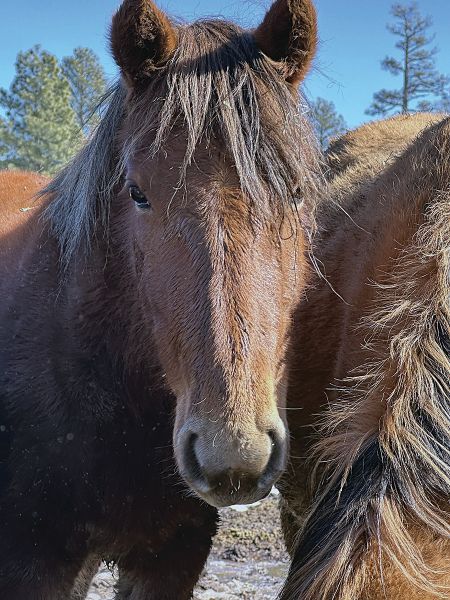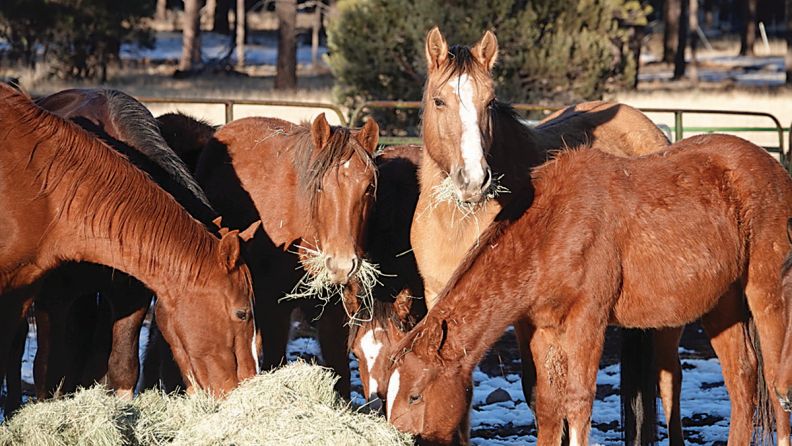By Heidi Dahms Foster

In December 2022, Molly Wisecarver was contacted by Circle L, a horse rescue in Prescott Valley. A friend who works there knew the Wisecarvers had just moved to a large property in Williams and might have room for a band of horses in need from the Alpine Wild Horse herd.
Without intervention, the herd would be broken up as there were so many stallions along with the mares. Unlike Bureau of Land Management requirements, the Alpine horses came with no other rules but that the Wisecarvers had secure areas to keep the stallions. The family quickly prepared a large arena area to welcome the herd.
The anticipation wasn’t without a few fraught moments, though. Wisecarver received phone calls from friends and others who knew what she was doing, who told her the animals would be dangerous.
“The amount of rancher friends who told me I was crazy for helping the horses was insane,” she said. “We even had a good friend come to our place to try to talk us out of it. He said the horses would break out of the arenas, kill my dogs if they got into the pens (which by the way they are very good with my dogs and don’t even look at them). I was hurt that so many people tried to talk me out of taking the horses, especially friends. I am really glad I didn’t listen. Everything has settled down since nothing happened.”
When the horses arrived, Wisecarver said, “I was worried they would be crazy at first and run though the panels and escape. But they were very calm when they came out of the trailer. They settled in very fast. I think living in the forest, they were probably used to seeing campers and vehicles.”

Since the horses arrived in December, they have settled in and are thriving. “I have the Eagar Band. They name the main stallions after areas near Alpine. This band consisted of the lead stallion and three mares. Two of the mares had two babies, a yearling and two-year-old. One of the three mares was left in the forest, but found in the second roundup a month later. I drove to Holbrook to transport her and her yearling colt.
During this past winter, the band in the large arena for the winter, so Wisecarver could watch them and feed them since the area experienced record-breaking snowfall.
“They did break out recently and had the whole 150-acre property to run on. It was so beautiful to see them free. Our boundaries are not well fenced at this time but we are working on getting it all fixed,” Wisecarver said. “The crazy thing is they never left. They just hung out in the tree lines and the meadow.”
Then they returned to the main ranch area. “One day they came back to the original arena where they were kept during the winter,” Wisecarver said. “That made me smile as I felt they figured they were home. Another theory is they came back so one of the mares could have her baby in a safe place. Once we get the property fencing completed, we will let them back out.”
Three mares arrived pregnant and one had a colt in late April. “It was so exciting as I was able to watch the whole thing,” Wisecarver said. “It is amazing how fast they get up. I was going to name it April but since it is a boy I will have to think of a new name. One more mare is due very soon but it looks like the other will still be a few months out.”
When the April foal arrived, the entire band was there,” Wisecarver said. “When the foal stood up for the first time, his older siblings and mother surrounded him to protect him. They kept him in the middle of the band for hours.”
The three stallions in the band continued to get along, until spring neared. “Then things changed. It was very interesting to watch their behavior,” Wisecarver said. “As the mares started to come into heat, things got worse and I had to separate the stallions. This was easier than I thought as the young bachelors were more than happy to get away from Eagar. All of the stallions have now been castrated so things are starting to calm down. At some point I will have to find new homes for the two young bachelors to keep the peace.”
One thing Wisecarver finds remarkable is how the wild horses get along with her four horses. “ “One of my horses was a stallion himself until he was five, so he wasn’t so sure about a new band coming to his home. My horse and the Eagar band were introduced through pipe coral panels and shared food for several months and now get along. My small band and the Eagar band when loose stay close to each other but never intermingle.”
Wisecarver said her wild horse experience has been a bit of a roller coaster ride. “I think if the winter wasn’t so hard, it might have been easier,” she said. “I was not prepared for the snow, let alone 11 new horses and only living there a few months before they arrived. I am still learning so much – each day is a new experience. Unfortunately, the winter was too hard on a young foal that was struggling when she arrived. We tried everything but lost her. But on a brighter note, we gained a new baby who is happy and healthy.”

She advises anyone who has room and can take on a herd temporarily to be sure they know there will be good days and bad. “Don’t be afraid to ask for help and remember you are doing a GREAT thing. This will keep you going. I didn’t know what I was getting into, but I would do it again if asked.”
“What I have learned more than anything is that if you want to survive you will, and working together helps. One horse came in with a large knee injury and another with what we thought was a broken leg. Both healed on their own without issues. Since they are wild it is hard to doctor them when needed. Nature has a way of taking care of things.”
“At one point,” Wisecarver said, “with the crazy weather this year, we couldn’t water them because it would just freeze. I was so worried about them. One day when I was feeding, I noticed they were eating the snow. Since our pond was frozen, I figured any pond in the Alpines would also be frozen, too. They were used to eating snow to survive.”
The Eager band will be transported to safety in Colorado sometime in the next few months, but the Wisecarver finds herself passionate about what is happening to the remaining Salt River herds in the Tonto National Forest.
The Salt River Wild Horse Management Group is working to make sure these horses can be enjoyed for many years to come as they have been by millions of visitors in the past. According to the Management website, “the Alpine wild horses roam freely in their 20,000-acre habitat along the lower Salt River, protected by A.R.S 3-1491, the State law passed in 2016 for their protection. They are the pride of the community, a favorite subject of photographers and the icon of the wild, free spirit of Arizona and the American West.”
The group has instituted a birth control program that has reduced the foaling rate in the herd from 100 foals each year, to just one or two per year, so the herd can stay in balance with its habitat.
However, the Group states, the management program and the necessary intergovernmental agreements between the Tonto National Forest and the Arizona Department of Agriculture, along with the overwhelmingly passed state legislation that enabled them, are under constant attack.
For more information about the Salt River Wild Horses, the challenges they face, and how you can help, visit the website at saltriverwildhorsemanagementgroup.org.


